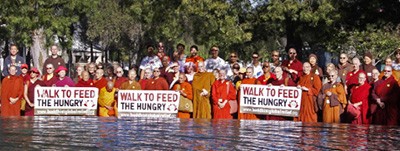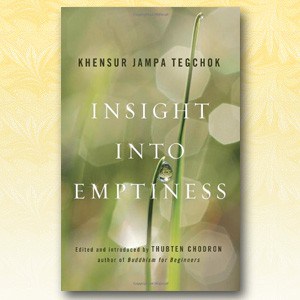Developing and sustaining bodhi resolve
Practicing with joy in challenging times

Report on the 18th annual gathering of Western Buddhist monastics, held at Deer Park Monastery in Escondido, California.
Established in 2000 on a 400-acre property once used to train SWAT teams, Deer Park Monastery is a branch of Vietnamese Zen Master Thich Nhat Han’s famed Plum Village. This craggy land of steep heights, honey-scented sage, and hardy native oaks has been gentled by the peaceful mindfulness of the resident community, who opened their home and their hearts to the 41 monastics attending this 18th Annual Buddhist Monastic Gathering.
Monks and nuns from the Theravada, Tibetan, Vietnamese, Soto Zen, and Chinese traditions—in an array of earth-toned robes—readily joined into the Deer Park community. A particular joy this year came from witnessing the growth of the Theravada bhikkuni sangha, with 14 Theravada nuns participating in the gathering.
Our topic was broad: How to Develop and Sustain Bodhi Resolve—with Joy—in Challenging Times. Through two daily councils, several breakout groups, many informal talks in the dining hall and tea room, and long walks to visit the pagoda and white marble Buddha at the top of a sharp hill, monastics shared the joys and challenges of our practice and our lives.
Rev. Seikai Leubke, from the Order of Buddhist Contemplatives, set an open tone with his frank 1st Council sharing. “I’m the last person to talk about joy,” he began with a smile, “as I tend toward a depressive personality.” He explained how he has applied the Dharma and reflections on Buddha nature through 35 years of monastic life to cultivate acceptance of inner and outer challenges and to maintain a balanced, peaceful mind. The ensuing discussion revealed that many in our group are familiar with the suffering of depression, and they shared their experiences of working with it and through it.
Ven. Bhikkhu Bodhi, from the Sri Lankan Theravada tradition, explained in the 2nd Council that bodhicitta has a place in all Buddhist traditions. He noted two aspects of bodhicitta: one that looks up to the Buddhas and one that looks out to sentient beings. With the suffering of sentient beings in mind, he explored some of the causes of today’s “challenging times.” Pernicious war pervades the planet. Neo-liberal economic policies—unregulated “free” markets that use profit as the sole measure of success—fuel the widening gap between (the few) rich and (the many) poor. Potentially devastating climate change stems from unchecked human behaviors in the wealthiest parts of the world. What is the role of Buddhist monastics in the face of this suffering? For Bhikkhu Bodhi, compassion compels us to combine activism with spirituality. He challenged us to become “spiritual activists” and set the stage for his next presentation at the gathering.
Members of the Deer Park community gave an evening session to share and answer questions about their monastic training, and community life. They modeled respect and kindness as they spoke of their practice to regard one another as family—brothers and sisters in the Dharma. Concentric circles of leadership govern the community, and all decisions are consensual. A teacher is someone who can generate her own happiness, knows how to do it deliberately, and can help others do so well as well. The guest monastics were keen to hear how Deer Park cultivates its palpable harmony.
- Ven. Thubten Chonyi opened the 3rd Council. Speaking briefly about the thought-training practices of the Tibetan tradition, she guided the assembly to create our own “thought-training texts” based on our experiences. Sharing in groups of three or four, we each spoke about a time when our bodhi resolve was challenged, what Dharma antidotes we used to overcome it, and what we learned from the experience. Then, using a Malaysian poetry formula called a “pantoum,” each small group created verses on how to develop and sustain bodhi resolve—with joy—in challenging times. Each group read its poem, and we were delighted and sometimes surprised at the beauty and wisdom wrought from our challenges.
- In the 4th Council, Ayya Tathaaloka Theri spoke of developing bodhicitta through examining the four establishments of mindfulness: mindfulness of the body, feelings, mind, and dharma or phenomena. “Phenomena” include the five hindrances, five aggregates, and six sense bases, all of which obstruct our joy and are to be abandoned. “Phenomena” also contains the seven factors of enlightenment—including joy itself— which are to be cultivated. “In our monastic life,” she said, “it would be a loss for us not to touch this joy of the Dharma. If we cultivate this love for ourselves and others, we will find joy.” Through our practice, she advised, we must create the causes for joy to manifest.
- In the evening, Ven. Bhikkhu Bodhi, supported by Ajahn Gunavuddho and Sister Santussika, continued the spiritual activist theme of his previous talk with an introduction to Buddhist Global Relief (BGR), which he founded to combat chronic hunger and malnutrition. In addition to informing and inspiring us, this session prepared us for a monastic “walk for hunger” scheduled the next morning.
- For the 5th Council the Deer Park community rustled up cars and volunteer drivers to ferry the monastic group into Escondido Thursday morning for the BGR Walk for Hunger. Bhikkhu Bodhi led the way, carrying a banner that proclaimed, “Walk to Feed the Hungry.” Silently, the 50 or so monastics and assorted lay supporters circumambulated Grape Day Park, receiving smiles, waves, honks, and stares from passing motorists and pedestrians. The walk ended in a picnic, provided by Deer Park, and a quiet rally featuring several talks, including Bhikkhu Bodhi’s eloquent, passionate, and compassionate call to action to address suffering where we find it.
- Ven. Karma Lekshe Tsomo, from the Tibetan tradition, led our 6th and final Council with two PowerPoint presentations. In “Buddhism in Contemporary Culture: Challenges and Opportunities,” she showed a selection of covers from Buddhist periodicals, giving a broad overview of themes in American Buddhism. She followed that with a delightful slideshow of her life. Raised in Hawaii, a surfing competition took her to Japan, from whence she found her way to India and Tibetan Buddhism. Ordained as a novice nun in 1972, she had no idea that full ordination wouldn’t be available to her. This launched her lifelong activism on behalf of women in all Buddhist traditions. Someone asked how she had endured her many challenges and hardships with joy. Forceful and smiling, she replied, “Joy or no joy, you just keep going!”
The gathering schedule allowed for spontaneous breakout groups, which discussed American idealism and its influence on Buddhist practice, climate change and what we can do to avert disaster, and a meditation to strengthen kidney chi among other topics. In addition, the Theravada bhikkunis met together, and in a moving ceremony marked by monastics chanting in the prayers and languages of their various traditions, we spread the ashes of a nun’s recently deceased father beneath a young bodhi tree near the white marble Buddha in the Deer Park hills.
The closing session called for evaluations, a new location, new leaders, and a new theme for 2013 when we’ll focus our gathering on Buddhist Monastic Formation.
Some of the attending monastics live in monasteries or small monastic communities. Others live and practice in Dharma centers, and some live more or less on their own. A few presently experience life as “itinerant mendicants,” following the winds of karma as they seek a practice community or location most suitable to them.
All of us—including the monastics from the Deer Park community—reveled in living joyfully together for a few days. Like the late summer bees in the remaining blooms in the Deer Park gardens, we’ll take this gathering’s nectar to our own communities, pollinating our experience as monastics with the wisdom, courage, and inspiration gleaned from our 18th annual gathering.
Venerable Thubten Chonyi
Ven. Thubten Chonyi is a nun in the Tibetan Buddhist tradition. She has studied with Sravasti Abbey founder and abbess Ven. Thubten Chodron since 1996. She lives and trains at the Abbey, where she received novice ordination in 2008. She took full ordination at Fo Guang Shan in Taiwan in 2011. Ven. Chonyi regularly teaches Buddhism and meditation at the Unitarian Universalist Church of Spokane and, occasionally, in other locations as well.


